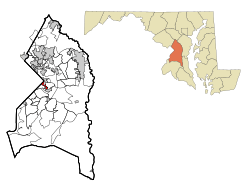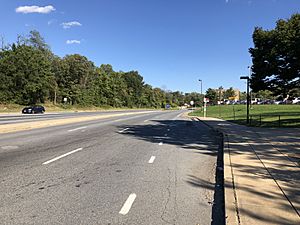Capitol Heights, Maryland facts for kids
Quick facts for kids
Capitol Heights, Maryland
|
|
|---|---|

Location of Capitol Heights, Maryland
|
|
| Country | |
| State | |
| County | |
| Incorporated | 1910 |
| Area | |
| • Total | 0.78 sq mi (2.02 km2) |
| • Land | 0.78 sq mi (2.02 km2) |
| • Water | 0.00 sq mi (0.00 km2) |
| Elevation | 121 ft (37 m) |
| Population
(2020)
|
|
| • Total | 4,050 |
| • Density | 5,185.66/sq mi (2,002.72/km2) |
| Time zone | UTC-5 (Eastern (EST)) |
| • Summer (DST) | UTC-4 (EDT) |
| ZIP codes |
20700-20799
|
| Area code(s) | 301, 240 |
| FIPS code | 24-13000 |
| GNIS feature ID | 0597177 |
Capitol Heights is a town in Prince George's County, Maryland, United States, located on the border of both the Northeast & Southeast quadrants of Washington. Per the 2020 census, the population was 4,050. The town of Capitol Heights is officially bounded between Southern Avenue NE/SE to the north, Yost Place, and Eastern Avenue NE to the east, the Watts Branch Stream, Brooke Road, and Capitol Heights Boulevard to the south, and Marlboro Pike to the west. The zip code of Capitol Heights is 20743.
Contents
Bordering areas
- Coral Hills (southwest)
- Seat Pleasant (northeast)
- Washington, D.C. (northwest)
- Fairmount Heights (north)
- Walker Mill (southeast)
Geography
Capitol Heights is located at 38°52′55″N 76°54′52″W / 38.88194°N 76.91444°W (38.881862, -76.914474).
According to the United States Census Bureau, the town has a total area of 0.80 square miles (2.07 km2), all of it land.
Previous mayors
- 1946-1950 Thomas A. Shaw
- 1950-1952 Harvey E. Ennis
- 1952-1954 Joseph Gainer
- 1954-1964 Elmer L. Hockman
- 1964-1986 Leo P. Forami
- 1986-2002 Vivian M. Dodson
- 2002-2006 Joyce Ayers Nixon
- 2006-2010 Darrell A. Miller
- 2014-2018 Marnitta L. King
Demographics
| Historical population | |||
|---|---|---|---|
| Census | Pop. | %± | |
| 1920 | 1,194 | — | |
| 1930 | 1,611 | 34.9% | |
| 1940 | 2,036 | 26.4% | |
| 1950 | 2,729 | 34.0% | |
| 1960 | 3,138 | 15.0% | |
| 1970 | 3,835 | 22.2% | |
| 1980 | 3,271 | −14.7% | |
| 1990 | 3,633 | 11.1% | |
| 2000 | 4,138 | 13.9% | |
| 2010 | 4,337 | 4.8% | |
| 2020 | 4,050 | −6.6% | |
| U.S. Decennial Census 2010 2020 |
|||
2020 census
| Race / Ethnicity | Pop 2010 | Pop 2020 | % 2010 | % 2020 |
|---|---|---|---|---|
| White alone (NH) | 110 | 79 | 2.54% | 1.95% |
| Black or African American alone (NH) | 3,920 | 3,294 | 90.39% | 81.33% |
| Native American or Alaska Native alone (NH) | 3 | 12 | 0.07% | 0.30% |
| Asian alone (NH) | 5 | 15 | 0.12% | 0.37% |
| Pacific Islander alone (NH) | 0 | 0 | 0.00% | 0.00% |
| Some Other Race alone (NH) | 1 | 22 | 0.02% | 0.54% |
| Mixed Race/Multi-Racial (NH) | 65 | 94 | 1.50% | 2.32% |
| Hispanic or Latino (any race) | 233 | 534 | 5.37% | 13.19% |
| Total | 4,337 | 4,050 | 100.00% | 100.00% |
Note: the US Census treats Hispanic/Latino as an ethnic category. This table excludes Latinos from the racial categories and assigns them to a separate category. Hispanics/Latinos can be of any race.
2010 census
As of the census of 2010, there were 4,337 people, 1,482 households, and 1,040 families residing in the town. The population density was 5,421.3 inhabitants per square mile (2,093.2/km2). There were 1,622 housing units at an average density of 2,027.5 per square mile (782.8/km2). The racial makeup of the town was 3.3% White, 91.3% African American, 0.3% Native American, 0.1% Asian, 3.1% from other races, and 1.9% from two or more races. Hispanic or Latino of any race were 5.4% of the population.
There were 1,482 households, of which 42.0% had children under the age of 18 living with them, 34.0% were married couples living together, 28.4% had a female householder with no husband present, 7.8% had a male householder with no wife present, and 29.8% were non-families. 25.1% of all households were made up of individuals, and 7.3% had someone living alone who was 65 years of age or older. The average household size was 2.92 and the average family size was 3.48.
The median age in the town was 34.9 years. 27.3% of residents were under the age of 18; 10.3% were between the ages of 18 and 24; 27.3% were from 25 to 44; 26.1% were from 45 to 64; and 9.1% were 65 years of age or older. The gender makeup of the town was 46.0% male and 54.0% female.
History
In 1904, Washington, D.C., was growing by leaps and bounds. The overcrowding and the improved public transportation made the idea of living on the outskirts increasingly appealing to people looking for housing. Recognizing the opportunity, Baltimore resident Otway B. Zantzinger acquired 400 hilly acres just beyond the eastern corner of the District of Columbia. He divided the tract into 4,000 lots and began to sell them at prices ranging from $20 to $150 each. He advertised a picturesque view of Washington, D.C., a proposed electric railway, drinking water from crystal-clear springs, nothing down and a dollar a month, no interest, no landlords, and, in the custom and vernacular of the times, "no colored people." Many buyers bought two lots in this haven that was to become Capitol Heights.
While awaiting their "proposed electric railway," commuters to the city could walk about a mile (often through mud) to the District Line station at what is now Seat Pleasant and board a rail car into Washington, DC.
The absence of paved roads, sidewalks, street lights, and other public services, including the electric railway, began to cast a pall over Zantzinger’s vision of bliss. In 1910, the approximately 200 householders voted to incorporate their community as Capitol Heights. Over the next 50 years, the town made strides in improving its infrastructure and services. It established its own fire department and public works department and built facilities to house them and other elements of the government. By the 1970s, when its population had reached about 3,800, the town’s central business district had started to decline.
A rebuilt Central Avenue had diverted lucrative traffic around the town, and parking facilities were inadequate for what traffic there was. Rising instances of crime and modest incomes of the residents were cited as other reasons for the town’s ailing economy. The town established its own police department and pinned its hopes on the planning reports of the Washington Metropolitan Area Transit Authority.
In 1980, that long-promised "electric railway" finally arrived. Capitol Heights got its own station on the Washington Metro Blue Line, providing easy access to the entire metropolitan region and national transportation facilities. The land around the station has been declared an Enterprise Zone, which the town is promoting as one of its paths to restoring prosperity. Today, over 95% of the population of Capitol Heights is African-American, and the town has had four African-American mayors.
Community organizations
The Capitol Heights/Seat Pleasant chapter of the Prince George's County Boys and Girls Club, supports the youth with after-school programs and athletic programs, along with mentoring boys and girls.
The Capitol Heights conflict-mediation program focuses on resolving differences between youths in the area.
Education
Capitol Heights is a part of the Prince George's County Public Schools system. Residential areas of Capitol Heights are zoned to the following schools: Zoned elementary schools for the municipal limits are Capitol Heights, William Hall, and Doswell Brooks. William Hall and Walker Mill middle schools serve sections of the municipality. Central High School and Suitland High School serve sections of the municipality.
Transportation
The primary highway serving Capitol Heights is Maryland Route 214. MD 214 extends west to Washington, D.C. (connecting with East Capitol Street) and east to Interstate 95/Interstate 495 (Capital Beltway). Maryland Route 332 also serves Capitol Heights, following an old alignment of MD 214.
Notable people
- Chad Scott, American football cornerback in the NFL, played for Pittsburgh Steelers and the New England Patriots
- James Tillman (1919–2009), Negro league baseball player, and a long time resident of Capitol Heights
See also
 In Spanish: Capitol Heights para niños
In Spanish: Capitol Heights para niños


